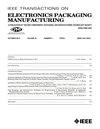Advanced Package Prototyping Using Nano-Particle Silver Printed Interconnects
IEEE Transactions on Electronics Packaging Manufacturing
Pub Date : 2010-03-22
DOI:10.1109/TEPM.2010.2044887
引用次数: 16
Abstract
To reduce manufacturing cost, lead time, and process complexity, an embedded-active approach that targets rapid prototyping and low-volume production in micro-system packaging is being developed. The approach involves a rapid prototyping of micro-system packaging by a data-driven chip-first packaging process using direct printing of nano-particle metals. In the chip-first process, bare dice are first embedded into a copper or stainless steel carrier substrate, fixed by filling the gap between the chips and the substrate with thermoplastic adhesives, and planarized to a common planar surface. On the coplanar substrate, polyimide film is laminated to form a dielectric layer. Through the dielectric layer to the chip metal pads, micro vias are drilled by laser ablation. The vias are filled with nano-particle silver (NPS). The NPS is deposited by screen printing or aerosol-jet printing and an electrical circuit is formed. This packaging approach is a dry process and it does not require any photo masks for circuit patterning, resulting in reducing packaging turn-around time from months to days. It is also less limited by substrate composition and morphology, eliminates the need for special chip processing such as flip chip solder bumps, and permits using any chip technology and any chip supplier allowing mixed devices. The embedded-active process with NPS avoids the extreme processing conditions required for standard IC fabrication such as wet chemistry processing and vacuum sputtering. The NPS can be sintered at plastic-compatible temperatures as low as 230?C to form material nearly indistinguishable from the bulk metal. The embedded-active packaging shows good reliability performance in terms of thermal shock, which is performed in the range of -40?C and 125?C. These results represent an important step to a system packaging characterized by high-density, low-cost, and data-driven fabrication for rapid package prototyping. This paper presents details of the rapid prototyping process sequence, an initial reliability characterization of the package architecture, and a failure mode analysis of the packages.使用纳米粒子银印刷互连的先进封装原型
为了降低制造成本、交货时间和工艺复杂性,一种针对微系统封装的快速原型和小批量生产的嵌入式主动方法正在开发中。该方法涉及通过数据驱动的芯片优先封装工艺,使用纳米颗粒金属直接印刷的微系统封装的快速原型。在芯片优先工艺中,首先将裸骰子嵌入铜或不锈钢载体基板中,通过用热塑性粘合剂填充芯片与基板之间的间隙来固定,并将其平面化成共同的平面。在共面衬底上,聚酰亚胺薄膜被层压以形成介电层。通过介质层到片状金属衬垫,用激光烧蚀钻出微孔。孔内填充了纳米粒子银(NPS)。通过丝网印刷或气溶胶喷射印刷沉积NPS,并形成电路。这种封装方法是一个干燥的过程,它不需要任何用于电路图案的光掩模,从而将封装周转时间从几个月减少到几天。它也较少受衬底组成和形态的限制,不需要特殊的芯片处理,如倒装芯片焊料凸起,并且允许使用任何芯片技术和任何芯片供应商允许混合设备。采用NPS的嵌入式主动工艺避免了标准IC制造所需的极端加工条件,如湿化学加工和真空溅射。NPS可以在低至230℃的塑料兼容温度下烧结。C形成与大块金属几乎无法区分的材料。嵌入式有源封装在热冲击方面表现出良好的可靠性,在-40?C和125?这些结果代表了系统封装的重要一步,其特点是高密度、低成本和数据驱动制造,用于快速封装原型。本文详细介绍了快速成型工艺流程、封装体系结构的初始可靠性表征以及封装的失效模式分析。
本文章由计算机程序翻译,如有差异,请以英文原文为准。
求助全文
约1分钟内获得全文
求助全文

 求助内容:
求助内容: 应助结果提醒方式:
应助结果提醒方式:


